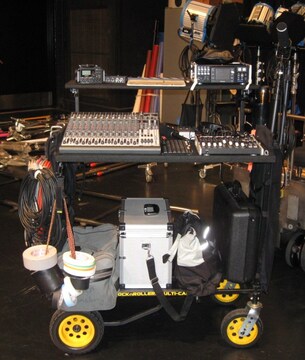 It has been said that if you were to ask 300 professional sound mixers to describe their idea of a perfect soundcart, you would get at least 500 different answers!
It has been said that if you were to ask 300 professional sound mixers to describe their idea of a perfect soundcart, you would get at least 500 different answers!
Everyone in this business has their own concept of what they like and what works best for them in the field. There is no correct answer, and even a large percentage of production mixers cannot even settle for one design.
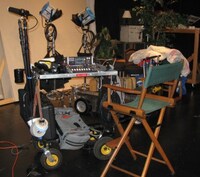 This article, therefore, are the opinions of just one person: me. True, a lot of mixers agree with what I have to say, but nothing in this article should be construed as the industry gospel. It is only the rants and ravings of yours truly, Fred Ginsburg CAS.
This article, therefore, are the opinions of just one person: me. True, a lot of mixers agree with what I have to say, but nothing in this article should be construed as the industry gospel. It is only the rants and ravings of yours truly, Fred Ginsburg CAS.
The soundcart is the portable workstation or work desk of the Production Sound Mixer. It is where we sit, manage our recorders, and operate our mixing panel.
Oftentimes, but not always, it is where we base our wireless mic receivers. (There are times, however, when I find it advantageous to move the receivers closer to the actors and just cable back to my cart.)
Soundcarts are also where we stow most of our gear, or at least the stuff that we regularly need to keep close by. Microphones, cables, batteries, clip board, laptop, and so on.
Soundcarts need to be portable. They have to be transported to the location and then parked just on the edge of the shooting set. And they constantly have to be re-positioned as lighting or cameras inevitably want to occupy whatever real estate we initially stake.
There are some mixers who prefer to park themselves near the back of the stage and out of the way, but I strongly advocate positioning the cart right on the edge of the set and close to the “action”. As a mixer, I need to see the relationship of actors and microphones (booms, plants). I find it important to note body language, as that will foreshadow the vocal performance during takes. Eye contact and the ability to make silent hand gestures to the Director as well as my boom operators during a take are my way of communicating during a take.
We can classify soundcarts as uprights or gurney style.
In the older days of filmmaking, when Nagra reel-to-reel recorders reigned the earth, the upright style was the popular solution. The early carts were based on golf caddy or wheelchair designs. Tilt them back to balance the weight onto two large wheels and then roll them to your destination where you would return them to full upright, standing them on either two small front casters or a fixed rest.
Carts did not need to be big. Nagras did not take up that much space, and the mixing panels that we used with them also had fairly small footprints. A normal complement of radio mics was four systems, and they stored in what we called a quad-box that provided central powering and antenna. Quad-boxes resembled a large lunch pail or shoe box, rather than the rackmounted systems of today.
Many of the homemade uprights were made by welding shelves to the vertical components of golf caddies or industrial hand trucks. Most did not fold.
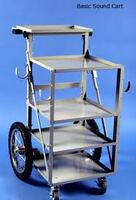 Sound companies like Skyline Productions and PSC soundcart (Location Sound Corp) began manufacturing upright carts that could fold flat for shipping or storage, much like a folding chair. These carts offered multiple shelves and optional accessories to maximize their capacity.
Sound companies like Skyline Productions and PSC soundcart (Location Sound Corp) began manufacturing upright carts that could fold flat for shipping or storage, much like a folding chair. These carts offered multiple shelves and optional accessories to maximize their capacity.
With the advent of video production and then digital audio recording -- sound mixers found that they often needed more workspace to house larger mixing boards, video monitors, laptops, external hard drives, and yet more radio mics.
Upright carts did not always offer enough shelf space for all of the toys. Sound mixers began looking at four wheeled horizontal cart designs (aka gurney style).
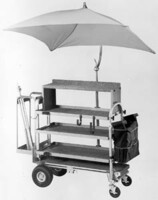 Magliner carts are industrial hand trucks that can operate as either upright or horizontal carts. Companies began offering custom modifications such as extended front toes, full height sides, removable top shelves, and all variety of accessories to convert these heavy duty hand trucks into mobile long carts.
Magliner carts are industrial hand trucks that can operate as either upright or horizontal carts. Companies began offering custom modifications such as extended front toes, full height sides, removable top shelves, and all variety of accessories to convert these heavy duty hand trucks into mobile long carts.
I have used Magliners over the years, and – properly modified – they make great carts. Except that they are heavy and not so easy to ship, unless you have a van or large SUV. Not a problem if you are working for a major studio or large production company that provides large camera/sound trucks or takes care of the freight arrangements, but their size can be an issue if you do a lot of smaller scale independent work or commercials.
Backstage Equipment manufactures carts similar to the Magliner but are dedicated designs for our industry. Their carts do not convert to full upright, but why would we want them to? We’re moving sound equipment, not cases of soda! Last year at NAB, we featured a decked out Backstage cart at our Audio Technica presentations on production sound.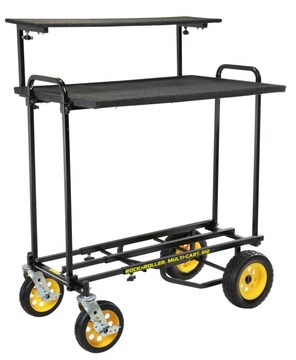
My favorite cart is the Rock N Roller R-12. These carts were originally intended for musicians, so they do require some mods. The R-12 features four large diameter tires, which is very important for traversing rough terrain or minor obstacles. I have found that smaller diameter casters just do not make the grade if you have to roll over large cables, grass, door jams, and so on.
The R-12 frame telescopes from 34 to 52 inches, for compact shipping or tight interior sets; or fully extended when space is not an issue.
The original factory shelf kits are available, but they consist of carpeted plywood that are way too narrow for our purposes. The shelves consist of two sections that can be joined when the cart is fully extended, or left separated for compact deployment. On my carts, I have added lightweight aluminum (oil drip) pans that offer me a 24 inch deep by 36 inch long work surface, with lip. I can add a second mid-shelf underneath that is only 18 inches deep, so that I have room for my knees when I sit.
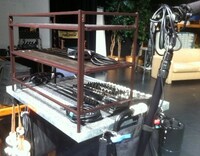
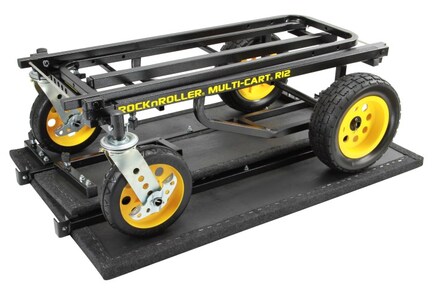 What I love about the Rock N Roller is its ability to quickly disassemble for shipping. The two upright sides fold flat, the lightweight frame telescopes, and the shelves just nestle on the frame (with the aid of some Velcro or a bungee cord).
What I love about the Rock N Roller is its ability to quickly disassemble for shipping. The two upright sides fold flat, the lightweight frame telescopes, and the shelves just nestle on the frame (with the aid of some Velcro or a bungee cord).
Interestingly, I had one of my soundcarts on display at the Tascam booth at the last NAMM Show (2012), and I met the owner/founder of Rock N Roller. Based on some of my suggestions, he is currently designing a dedicated cart for film/video, which will feature the larger shelves and a hutch arrangement.
We actually debuted the new model at NAB 2012, displayed in the Audio Technica booth.
What you see illustrated is the new Multi Media 2-tier workstation kit, which consists of a main wooden shelf, 36x24, carpeted, and with a 1/2 inch lip to keep your stuff from rolling off. Above the main shelf is a hutch, 36x10, also carpeted wood. The hutch quickly attaches/detaches by means of two C-shaped metal tubes that mate with receptacles under each shelf. Just a quick twisting lock; no tools required. For storage, the tubes can be inserted so as to lay flat.
The list price for the new Multi Media 2-tier Workstation is under one hundred dollars for the shelf kit, which mounts onto most of the Rock N Roller frames, such as the R12, R10, R8. The large R12, which features four large all terrain wheels. is around three hundred dollars. So the frame and shelf kit together list for under four hundred, and could probably be purchased from a good dealer for under $400.
So once you have purchased or built your cart, what should go on it? There are two schools of thought.
Some mixers like to keep everything within arm’s reach, and their carts resemble mobile hardware stores! You name it, you imagine it, and it is in a drawer close by. The main gear – recorder, mixing board, wireless rack – all are in place and ready to go, usually on slide-out shelves of some sort. Fast, convenient, and efficient. Very often, the work center is self-contained in a cart mounted shipping case that can be closed up and ready for transport.
There are drawbacks to this packaged arrangement. The layout is based on one set of equipment; and unless you are doing a long run television series or feature film, you may need to set up different recording channels (aka packages) from assignment to assignment. Different recorders, different mixing board, and so on. The “super package” is not conducive to re-configuring its major components.
The other downside to the “super package” is weight. The shipping case adds a lot of pounds to the overall weight of the cart and components. What you gain in speed of setup, you lose when you have to relocate to any site not on a level path from you. It can take a lot of cajoling to motivate a few strong bodies to heft this behemoth up a flight of stairs!
Personally, I do not care for the “super package”. But as I have pointed out previously, there are a lot of highly respected production mixers who find it very convenient to work that way, and do not have a problem with their custom configurations or with transportation.
When I first began mixing, we used small upright style carts. I was taught to keep my mixing cart light and mobile, and only stock it with what I needed to keep close at hand. The remainder of my equipment package was stored on a heavier Magliner cart in the back of the stage, where it was accessible by my crew if we needed additional supplies or gear.
I still follow that work habit today. I keep my primary soundcart minimalistic, and stow additional cases and supplies separately.
Whether you go with the “super package” or lightweight approach, there are things that all soundcarts will be laden with.
Audio recorder. Spare recording media. A mixing panel or remote fader controller for said recorder. Laptop computer for transferring your audio files. Radio mics. Clipboard and log sheet (or smart tablet). Lavalier rigging kit. Extra shotgun mics, plant mics, and lavs. Extra mic cables. Maybe an external antenna for the radio mics. Boompole holder on side of cart. Duplex cable. Comtek transmitter system for sending audio feed out on set to Director, Script, etc. Special cup holder for your coffee so that it cannot spill onto your gear.
Sometimes you may even have a video monitor or two.
One trick that I did pick up from one of my mentors is to always keep a container of (dry) munchies on the cart for the Director to snack on. Find out what the Director likes, and provide him/her with a private stash. Candy, nuts, gummies, whatever. Just so long as they are dry and not coated in anything that might pollute the equipment. No Cheetos orange dust, loose salt, or anything messy.
Keeping that bowl or jar of snacks on the cart motivates the Director (and other key crew members) to come over to the mixer and kibbutz. It helps to remind the crew that Mixers are part of the production team, and that good dialogue tracks do not happen on their own.
I believe that the absolute worst thing in the world is to hide your soundcart off in a dark corner of the stage and to remain “invisible” to the front line crew (Director, DP, Script). Out of sight means out of mind.
Park yourself on the edge of the set, so that you can oversee the action and so that the Director and crew can see you (and communicate to you). If you are in someone’s way, well, that is why soundcarts have wheels.
You can view a wide variety of soundcarts from around the world at sound mixer Jeff Wexler’s website. You can also view the “Parade of Soundcarts” seminar, recently presented by the Cinema Audio Society.